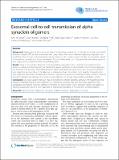| dc.contributor.author | Danzer, Karin M | |
| dc.contributor.author | Kranich, Lisa R | |
| dc.contributor.author | Ruf, Wolfgang P | |
| dc.contributor.author | Cagsal-Getkin, Ozge | |
| dc.contributor.author | Winslow, Ashley R | |
| dc.contributor.author | Zhu, Liya | |
| dc.contributor.author | Vanderburg, Charles R. | |
| dc.contributor.author | McLean, Pamela J | |
| dc.date.accessioned | 2013-04-08T17:23:49Z | |
| dc.date.issued | 2012 | |
| dc.identifier.citation | Danzer, Karin M, Lisa R Kranich, Wolfgang P Ruf, Ozge Cagsal-Getkin, Ashley R Winslow, Liya Zhu, Charles R Vanderburg, and Pamela J McLean. 2012. Exosomal cell-to-cell transmission of alpha synuclein oligomers. Molecular Neurodegeneration 7: 42. | en_US |
| dc.identifier.issn | 1750-1326 | en_US |
| dc.identifier.uri | http://nrs.harvard.edu/urn-3:HUL.InstRepos:10510848 | |
| dc.description.abstract | Background: Aggregation of alpha-synuclein (αsyn) and resulting cytotoxicity is a hallmark of sporadic and familial Parkinson’s disease (PD) as well as dementia with Lewy bodies, with recent evidence implicating oligomeric and pre-fibrillar forms of αsyn as the pathogenic species. Recent in vitro studies support the idea of transcellular spread of extracellular, secreted αsyn across membranes. The aim of this study is to characterize the transcellular spread of αsyn oligomers and determine their extracellular location. Results: Using a novel protein fragment complementation assay where αsyn is fused to non-bioluminescent amino-or carboxy-terminus fragments of humanized Gaussia Luciferase we demonstrate here that αsyn oligomers can be found in at least two extracellular fractions: either associated with exosomes or free. Exosome-associated αsyn oligomers are more likely to be taken up by recipient cells and can induce more toxicity compared to free αsyn oligomers. Specifically, we determine that αsyn oligomers are present on both the outside as well as inside of exosomes. Notably, the pathway of secretion of αsyn oligomers is strongly influenced by autophagic activity. Conclusions: Our data suggest that αsyn may be secreted via different secretory pathways. We hypothesize that exosome-mediated release of αsyn oligomers is a mechanism whereby cells clear toxic αsyn oligomers when autophagic mechanisms fail to be sufficient. Preventing the early events in αsyn exosomal release and uptake by inducing autophagy may be a novel approach to halt disease spreading in PD and other synucleinopathies. | en_US |
| dc.language.iso | en_US | en_US |
| dc.publisher | BioMed Central | en_US |
| dc.relation.isversionof | doi:10.1186/1750-1326-7-42 | en_US |
| dc.relation.hasversion | http://www.ncbi.nlm.nih.gov/pmc/articles/PMC3483256/pdf/ | en_US |
| dash.license | LAA | |
| dc.subject | Alpha synuclein | en_US |
| dc.subject | Oligomers | en_US |
| dc.subject | Exosomes | en_US |
| dc.subject | Parkinson’s disease | en_US |
| dc.subject | Aggregation | en_US |
| dc.subject | Secretion | en_US |
| dc.title | Exosomal cell-to-cell transmission of alpha synuclein oligomers | en_US |
| dc.type | Journal Article | en_US |
| dc.description.version | Version of Record | en_US |
| dc.relation.journal | Molecular Neurodegeneration | en_US |
| dash.depositing.author | Vanderburg, Charles R. | |
| dc.date.available | 2013-04-08T17:23:49Z | |
| dc.identifier.doi | 10.1186/1750-1326-7-42 | * |
| dash.contributor.affiliated | Cagsal-Getkin, Ozge | |
| dash.contributor.affiliated | Winslow, Ashley R | |
| dash.contributor.affiliated | Vanderburg, Charles | |


